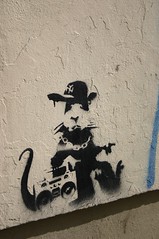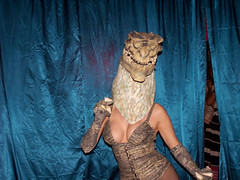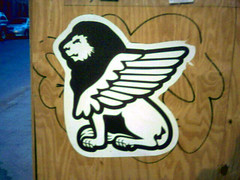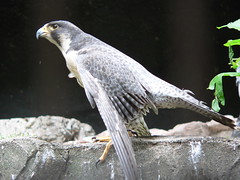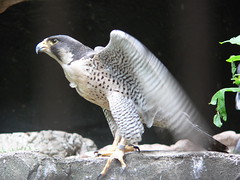The world is a mask that hides the real world.
Thatâs what everybody suspects, though the world we see wonât let us dwell on it long.
The world has ways - more masks - of getting our attention.
The suspicion sneaks in now and again, between the cracks of everyday existenceâ¦the bird song dips, rises, dips, trails off into blue sky silence before the note that would reveal the shape of a melody that, somehow, would tie everything together, on the verge of unmasking the hidden armature that frames this sky, this tree, this bird, this quivering green leaf, jewels in a crown.â¦
As the song dies, the secret withdraws.
The tree is a mask.
The sky is a mask.
The quivering green leaf is a mask.
The song is a mask.
The singing bird is a mask.
Saturday, May 28, 2005
elephant refugees

It's a Jungle Out There!
Ivory Coast's elephants seek peace abroad
by Loucoumane Coulibaly, 25 May 2005
ABIDJAN (Reuters) - Terrified by war and hounded by poachers, many of Ivory Coast's remaining elephants have packed their trunks and trundled off to more peaceful neighbors.
"Elephant populations have gone to Mali, Burkina Faso and Ghana since the outbreak of war. Wildlife officials in those countries have told us so," said Denis Amani Kouame, head of wildlife at Ivory Coast's agriculture ministry.
"Elephants don't like violence. They like tranquillity. They must have been the victims of abuse and have left the northern regions for neighboring countries," Kouame told Reuters. Elephants were widely distributed throughout West Africa for centuries but populations collapsed in the early 20th century after intensive hunting during the colonial period.
Ivory Coast was once one of the largest sources of West African ivory. But as forests were slashed to make way for cocoa and coffee plantations and hunting continued apace, elephant populations became fragmented and dwindled dramatically.
Kouame said there were about 3,000 elephants left when civil war broke out in September 2002 after a failed attempt by rebels to oust President Laurent Gbagbo but that it was hard to get a clear picture of how many were left.
Even before the war, which has cut the world's top cocoa grower in two, some African elephant experts said populations in Ivory Coast might already be far lower.
In a 2002 report, the African Elephant Database put definite sightings at 63 and said dung counts and other clues suggested there could be up to 666 in the West African country, which is slightly larger than Italy.
"Elephants are in danger in Ivory Coast. How can you comprehend that there might be no elephants left in a country called Ivory Coast?" said Kouame.
A tusked elephant head is the main feature on Ivory Coast's coat of arms and its soccer team is known as The Elephants.
Besides being hunted for their tusks, elephants are also prized in Ivory Coast for their meat.
The two main national parks with elephants in Ivory Coast are Comoe in the northern rebel-held zone near Ghana and Burkina Faso and Tai, in government-controlled territory near Liberia.
The government has come up with a program to boost elephant numbers in Ivory Coast over the coming decade which it estimates will cost 14 billion CFA francs ($27 million).
According to the plan, 48 protected elephant sites will be set up once the country is reunited and efforts to stamp out poaching and trade in ivory will be strengthened. Thirty of the sites will be in areas now under rebel control.

Friday, May 27, 2005
hey, this nuclear radiation stuff ain't so bad after all!

It's a Jungle Out There!
The Sun, 27 May 2005:
'Mutant' children are best
The Chernobyl nuclear disaster has spawned a generation of ‘mutant’ super-brainy children.
Kids growing up in areas damaged by radiation from the plant have a higher IQ and faster reaction times, say Russian doctors.
They are also growing faster and have stronger immune systems.
Radiation from the Ukrainian Chernobyl plant swept the globe and affected more than seven million people.
Professor Vladimir Mikhalev from Bryansk State University, has tracked the health of youngsters growing up in areas hit by the fallout since the 1986 accident.
He compared their mental agility and health to those in unaffected areas and found they came out top in tests.
The kids had been exposed to radiation in the atmosphere and their food supply.

falcon v. hawk
Falcon's injury from sky duel
Wound from red-tailed hawk grounds Bandit for week or two
by Bob Downing, Beacon Journal staff writer
It was the Falcon, small and speedy, vs. the Hawk, bigger and slower.
And in the aerial combat over downtown Akron, Bandit came down the loser.
Tom Henry, a wildlife biologist with the Ohio Division of Wildlife, said a window washer witnessed -- and people on Cascade Plaza heard -- the fight between Bandit, Akron's male peregrine falcon, and a red-tailed hawk about 4 p.m. Wednesday.
"He's too old for that," Henry said of Bandit's defense of his territory and nesting box with four chicks. "... and he came out worse for the wear."
The bloodied falcon was found on the ground near Bowery and South Main streets.
He is being treated by Dr. Gary Riggs, a Norton veterinarian, for a gash on the webbing of the left wing, a scraped leg and a loss of blood. But Bandit had no broken bones -- just soft-tissue damage to the muscles and tendons of the wing.
The falcon will be treated with antibiotics and anti-inflammatory drugs, Riggs said, and will be laid up for a minimum of a week or two to recuperate and regain his strength.
If there had been broken bones, Henry said, Bandit might have been shipped to the University of Minnesota Raptor Center for surgery.
Chesapeake, Bandit's mate, continues to care for the four chicks in the nesting box on the 11th floor of the U.S. Bank/Landmark Building. "She's trying," Henry said of Chesapeake's lone parenting.
But to help her out, the Division of Wildlife today probably will move one or two of the smaller chicks, which are not yet able to fly, into a Cleveland falcon nest. Henry said the nest at the International Steel Group complex (the former LTV Steel) in the Flats area has two adults and one chick.
The smaller Akron chicks were born within three days of the Cleveland chick, and that will make such an adoption more likely to work, he said.
The Cleveland falcons had five eggs, but only one hatched.
Moving chicks to other nests isn't uncommon.
In 2000, Bandit and Chesapeake adopted and reared four chicks from Cleveland.
And in 2001, three chicks from Akron were moved to other nests after a new male falcon, Flash, came to Akron, injured Bandit and killed one of the young birds.
Henry said moving chicks is a better option than providing food in the nesting box to supplement what Chesapeake would bring back for the four chicks. That could result in the young birds developing too quickly and in problems when they start to fly.
Fights between falcons and red-tailed hawks are not that unusual, Henry said. Recently, two falcons at the Cleveland Clinic -- Flash and Liberty -- battled and killed a red-tailed hawk, the largest and most common hawk in Ohio, he said.
Falcons are ``very aggressive toward other raptors... especially when they are defending their nests,'' said Dave Scott of the Ohio Division of Wildlife.
Bandit came to Akron in 1998 from Detroit. His first mate was J.P., also from Detroit. She was replaced by Chesapeake in 2001.
Bandit and his two mates produced 31 eggs from 1998 through 2005. Of that total, 23 hatched. Eight chicks died.
Falcons were formerly a federally endangered species and remain an endangered species in Ohio. There are perhaps 2,000 pairs in the United States.
Ohio has 22 pairs of falcons, of which 19 nested this year. Both totals are records. Ohio is expected to produce a record number of chicks, perhaps more than 70, when counts are finalized, Scott said. The record is 54 chicks from a record 15 nests in 2004.
....PREVIOUSLY:
Injury to downtown Akron falcon could be fatal
Akron Beacon Journal, 26 May 2005
Bandit, Akron's downtown peregrine falcon, was found bloodied and injured Wednesday afternoon with injuries that could prove fatal.
The falcon, approaching his 10th birthday, is being treated at the Metropolitan Veterinarian Hospital in Copley Township for unknown injuries.
Earlier this month, Bandit and his mate, Chesapeake, became parents to four chicks.
Bandit was found lying at South Main and Bowery streets, just below his family's nesting box on the 11th floor of the U.S. Bank/Landmark building. Downtown has been home to Bandit since 1996.
Tom Henry, wildlife biologist for the Ohio Division of Wildlife, said the fallen bird appears to have suffered leg and other injuries. Akron Zoo veterinarian Dr. Gary Riggs is treating the falcon and trying to determine the source of the bleeding.
Henry said he was unsure how Bandit was hurt. He said the injuries could have come from a battle with another bird or from running into a building. Bandit's injuries could be fatal unless the source of the bleeding is determined and treated, Henry said.
Five years ago, Bandit was found inside Canal Park suffering from a fractured wing after a battle with a foe.
Thursday, May 26, 2005
1,000 microchip-monitored falcons released

[photo: AME Info]
Treasured tradition remains of releasing falcons back into the wild
The skies over Chitral, Pakistan, near the Afghani border, were this year's choice for the eleventh annual release of falcons back into the wild.
AME Info, 23 May 2005
The release came under the Falcon Release Programme initiated by the late President of the UAE, Sheikh Zayed bin Sultan al Nahyan, and is conducted in the hopes that the birds will rejoin the wild population and contribute to its growth and conservation.
39 Saker and 47 Peregrine falcons were released back into the wild. They included the late President's own falcons, the falcons of HH Sheikh Khalifa bin Zayed Al Nahyan, President of the UAE and those of several other sheikhs and UAE nationals. Birds donated from the Kingdom of Saudi Arabia and Kuwait, as part of their contribution to the programme, were also released. Others falcons released included those previously confiscated by concerned authorities after having been smuggled into the UAE illegally. The confiscation of those illegal birds is part of the UAE's efforts to implement stricter wildlife trade regulations. 2 Peregrines and 2 Sakers were equipped with satellite transmitters to allow their movements to be tracked. One of those peregrines was owned by HH Sheikh Khalifa.
The release was organized under the supervision of Abu Dhabi's Environmental Research and Wildlife Development Agency (ERWDA), with the support of the Abu Dhabi Falcon Hospital and Falcon Foundation International (Pakistan). Organizers stated that this year in particular all birds were strong and in good shape.
As tradition goes, Arabian falconers release their birds back into the wild when the hunting season is over, but with the advent of modern technology and wealth, it has become easier to keep the best falcons year after year. However, Sheikh Zayed had always set an example and been keen to keep the tradition alive by releasing even his own falcons annually into the wild. Releasing the birds also helps to further research into the exciting phenomena of bird migration.
H.H Sheikh Hamdan bin Zayed Al Nahyan, the UAE's Deputy Prime Minister, Minister of State for Foreign Affairs and Deputy Chairman of ERWDA said that the release is just one of the many conservation efforts initiated by Sheikh Zayed and that it was a treasured tradition that will always be maintained.
This is the second time Chitral was chosen to release the falcons due to it being used as a migration route by Saker and Peregrine falcons moving northwards towards breeding grounds in central Asia.
Another consideration was the availability of water and prey species for the released birds. Saker falcons in the wild primarily feed upon small rodents and other terrestrial animals in the wild.
Annual bird migration has always been a source of fascination for humans and is often perceived as a spectacle and sometimes even a mysterious phenomenon. Scientists and researchers are intrigued by the birds' colossal avian achievements and often wonder how a bird can fly such tremendous distances without getting exhausted or die. Therefore, the preparations for the release programme began with strict veterinary procedures, which start by choosing which birds are to be released. The birds were placed in controlled isolation at the Abu Dhabi Falcon Hospital, managed by the Environmental Research and Wildlife Development Agency (ERWDA), to check for any bacterial infection, parasites and to ensure that they are virus free.
Only birds found to be free of infection were included in the final release programme, to guarantee that there is no chance of infecting the wild falcon population. To ensure their flight would be swift and efficient, each falcon underwent several weeks of specific training in a special camp and was fed a special diet to increase its weight, and thus improve its chances of survival during the crucial first two weeks of re-adaptation to life in the wild. The birds needed substantial reserves to fight against the elements and accomplish the extraordinary journey.
To facilitate subsequent identification in the case of recapture or being found dead, a microchip carrying a special identification number known as a PIT (passive induced transponder), weighing about 0.1 grams, was implanted under the skin of each bird. Moreover, each bird had a numbered ring (band) fitted around its leg, which was provided by ERWDA, as part of the Emirates Bird Ringing Scheme. Finally, the permit certificates from the Convention on International Trade in Endangered Species of Flora and Fauna (CITES) were obtained to allow the birds to be exported from the UAE and to be imported into Pakistan.
The late President's falcon release programme first began back in April 1995, when 107 falcons were released in the Kharan District of Pakistan's western province of Baluchistan. In the years to follow, the releases were carried out in the Gilgit District in north Pakistan in 1996 and in the Lake Issyk-kul area of Kyrgyzstan. In 1999, 79 falcons were released again in Gilgit District. In 2000, 111 Saker and Peregrine falcons were released near the Chinese and Pakistani borders. The following year, 75 falcons were released in Chitral District near the Pakistani-Afghani borders, while in 2002; the same area witnessed the release of 102 falcons. In 2003, 95 falcons were released in the skies over Gurgan Province, Iran, and last year, 76 were released near the Chinese-Pakistani borders bringing the total number of falcons released to around 1,000 falcons.
Wednesday, May 25, 2005
wings & six guns
Monday, May 23, 2005
a real horror show
Sunday, May 22, 2005
seen in the street
roachmobile

Control and Communication in the Animal and the Machine: Project Overview:
....The project-based element of "Control and Communication in the Animal and the Machine" consists of a cockroach-controlled mobile robot: a mechanical system that amplifies and tranlates the bodily movement and intelligence of a giant hissing madagascan cockroach into the locomotion of a mobile machine. The hybrid biorobotic system strives to illustrate that the simple embodied intelligence of a living cockroach provides a substantially captivating and novel control center ("central processing unit", CPU) for a mobile robot, producing tounge-in-cheek "emergent" and complex behavior akin to the goals of artificial life and artificial intelligence research....
The cockroach is placed on top of a modified trackball - a computer-mouse-type device - that is hooked up to some electronics. The cockroach is held gently in place above the ball so that when the cockroach moves it makes the ball spin: a little bit like a two-dimensional treadmill. The electronics (optical encoders) within the trackball send out small electrical pulses to some electronics that make the motors move in a similar direction to where the cockroach is moving on the ball....
The cockroach eats almost anything, although it is fed organic lettuce and canned Pedigree "Traditional Ground Dinner With Chopped Beef (Improved Recipe)" dog food. A couple of cockroaches have died after being fed Carl's Jr. - although this may have been a coincidence. As a sidenote, it is dangerous to feed cockroaches any fruit with a peel: almost all fruit bought in a grocery store is heavily sprayed with insecticide that will kill the insects....
Why is this project called "Control and Communication in the Animal and the Machine"?
This is a little bit of a long story.
In 1948, Norbert Wiener published a book titled "Cybernetics: on Control and Communication in the Animal and the Machine" in which he coined the term "cybernetics". He used this term to describe the science of transmitting messages between humans and machines, or from machine to machine. Wiener saw human communication as a model for human-machine and machine-to-machine interactions, and that the quality of these communications influenced one's inner well-being: especially in a society in which people increasingly interact with and are reliant on machines. As the term cybernetics stems from the Greek kybernetis meaning "steersman", the process of designing machines that effectively respond to us is important and has direct impact on our social condition.
All of this theory has a large influence on the history of computing, communications, robotics control theory, and many other fields. This project somewhat takes Wiener's title literally: it's interested in control and communication in the animal and the machine. It's also interested in the history and social impacts of cybernetic theory within contemporary culture: especially hybrid bio/machine systems....
the stars never lie

It's a Jungle Out There!
Animals receive guidance from the stars
by Julie Hunt, swissinfo, 22 May 2005
Ursula Liechti from Engelswilen in northeastern Switzerland believes she is the only astrologer in the world who produces horoscopes for animals.
The former business manager tends to focus on relationships between owners and their horses, dogs and cats.
Clients often consult the stars for insights into the sporting ability of a horse, or tips on dog training.
Occasionally farmers ask Liechti to cast horoscopes for their cows, to examine their milk production potential after an accident or sickness.
She simply enters the animal's date and place of birth in a computer programme, which produces the astrological chart.
Interpreting it is a rather more complicated process, and Liechti has been studying psychology to try to perfect her skills in this area.
She insists that you need both talent and training to be a good astrologer.
Auspicious beginnings
Liechti lives with her husband, two dogs and two horses on a quiet farm not far from the German border.
She first started consulting the stars for her own pets 15 years ago.
She was amazed at the accuracy of the chart she drew up for her horse, Mister Ginger.
"He was a jumper, very ambitious, and the horoscope reflected his learning behaviour and his sporting performance."
Liechti then started to collect data relating to top performing horses, to find out what qualities distinguished a jumper from a racing horse.
The characters of the riders were also of key importance.
Using horoscopes, she was able to determine whether a certain jockey was well suited to a particular racing horse.
Neigh to sporting career
Since these early beginnings, Liechti has cast hundreds of horoscopes for all types of animals, but horse owners are her most regular customers.
Liechti was recently asked if a young horse was well suited to dressage.
The astrologer pointed out that dressage horses not only need to be athletic, but also malleable, a quality indicated by the presence of the earth element in the animal's chart.
She believes the fire element is also important, as it shows that the horse is strong willed.
"The animal has to want to participate, otherwise it will not perform," she says.
From the fire and air symbols in this horse's horoscope, Liechti deduced that it was a brave animal with a strong desire for action, but that it would not be happy with the detailed, fussy work of dressage, so it was sold to a military rider instead.
Karin Brägger, a show jumper from Hütwilen, has three horses.
She was sceptical when she first approached Liechti for a physical analysis of her animals, but she was so impressed with the results that she now calls the astrologist every six months for a new chart.
The horoscopes seemed to show that one of the horses wanted to be given a longer leash, the second needed to be worked harder, and the third, a three-year-old, was not ready to be ridden.
"It really confirmed my own instincts about how I should be handling the horses," Brägger told swissinfo.
Doggy business
When customers seek advice on how to discipline their canines, Liechti says she can see from the stars whether the dogs need a strong hand or a lighter touch.
Yolande Ulmer, a masseuse from Bern, consulted Liechti when she acquired a second, younger Weimeran.
"I wanted to get an idea of how we would all get on with each other," she said.
The indications were that the older dog enjoyed being spurred on by the newcomer, who was much more lively.
"I appreciated the insights Ursula gave me into my own and my dogs' characters," Ulmer added.
Sometimes customers request guidance from the stars as to a canine's suitability for use as a mountain rescue or guide dog, or for policing.
The astrologer looks for signs of intelligence and a penchant for learning, obedience, reliability, courage and an ability to work independently.
Cat owners occasionally seek advice when their animals develop psychological problems, but so far, the astrologer has not been asked for guidance concerning rabbits, gerbils or guinea pigs.
In demand
The idea of horoscopes for cows, or, in fact, any four-legged beast, may seem outlandish to the uninitiated, but there is clearly a strong demand for the service in Switzerland.
Liechti has appeared on several TV chat shows, talking about her unique skills.
She says her two books have sold well and the phone never stops ringing with new requests for consultations.
Even she could not have predicted success on this scale.


